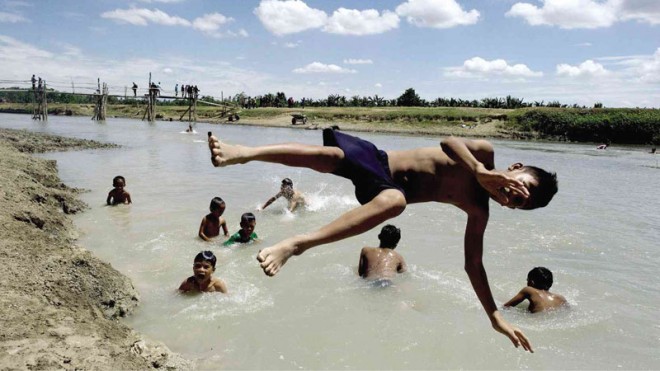Tukanalipao mired in poverty, war

RIVER FUN Children play in a river in Mamasapano, the scene of a bloody clash between police commandos and Moro rebels in Maguindanao province in January. AFP
TUKANALIPAO, Maguindanao—Farmer Lot Pangaoilan gazes toward a vast cornfield in Moro rebel-controlled Mamasapano in Maguindanao province, hoping that one day he will be able to farm his land without fear of being killed.
For two decades, he has been ploughing his 3-hectare land by hand and with the help of a carabao, worried that if he uses a heavy motor tractor he might detonate an explosive.
“If I’m not careful, I might hit a bomb … it could explode and I might die,” Pangaoilan, whose leathery skin, cloudy eyes and thin frame make him look much older than his 50 years, told Agence France-Presse (AFP).
Two months ago, Pangaoilan’s marshland village of Tukanalipao was the site of a daylong gun battle between Moro rebels and police that left more than 60 people dead as security forces hunted down alleged top terrorists.
READ: Full report: The Mamasapano incident
Article continues after this advertisementThe latest carnage has seriously jeopardized efforts to end a 4-decade-long Moro separatist rebellion that has claimed 150,000 lives, dimming hopes again that people such as Pangaoilan will be able to prosper in peace.
Article continues after this advertisementThe nation’s biggest rebel group, the Moro Islamic Liberation Front (MILF), signed a pact last year agreeing to give up its struggle in return for an autonomous homeland in impoverished Mindanao.
But the Jan. 25 battle in Pangaoilan’s village—in which 44 Philippine National Police Special Action Force commandos, 17 MILF rebels and at least three civilians died—triggered a huge political backlash that threatens the passage of a proposed national law endorsing the autonomous region.
READ: ‘BBL won’t pass if vote is taken now’
Deep poverty
The proposed Bangsmoro autonomous region would take in large parts of Mindanao, which the nation’s Muslim minority of roughly 5 million people regard as their ancestral homeland, including Pangaoilan’s village.
Despite fertile farming lands, vast mineral resources and idyllic beaches ripe for tourism, the region is the poorest in the country with nearly half of the population living in poverty, according to government data.
Tukanalipao, with no electricity or running water, is a typically impoverished Muslim community in Mindanao. Its 1,600 residents live in palm thatch houses on wooden stilts, with corn and rice farming their only source of regular income.
Pangaoilan has six children, but he was not able to afford to send them to school.
Military officials say villages like Tukanalipao make good recruiting grounds for the MILF, which has about 10,000 fighters, and other rebel groups.
In a typical cycle of violence and poverty that builds resentment, a military offensive launched after the January battle against a small breakaway rebel group opposed to the peace process, the Bangsamoro Islamic Freedom Fighters, displaced 120,000 people.
Two displacement camps with tarpaulin tents lie on a road close to Tukanalipao, although the military last week declared the offensive over and hopes the displaced people will soon return home.
READ: War-displaced civilians can now return home
Corn farmer Haji Maul said he had been in an out of evacuation shelters three times during the offensive to escape bursts of fighting near Tukanalipao, but this was not unusual.
“It has been a very difficult life for me and my family,” Maul, 60, told AFP, as troops wearing helmets and with their rifles pointed to the ground patrolled the parched earth, alongside carabaos, chickens and dogs.
Building peace
As part of its efforts to promote the peace process, President Benigno Aquino III’s administration has increased annual infrastructure spending on the region from P8 billion in 2010 to P24 billion this year.
In Tukanalipao, a sore lack of infrastructure is symbolized by a rickety patchwork of logs that its residents use to cross a stream and get to their farmlands.
When the stream overflows during the rainy season, work stops as farmers cannot get their animals across because the improvised bridge might fall apart, according to Pangaoilan.
READ: From ‘bridge of no return’ to bridge of peace
Last week, the government broke ground for a P10-million, 120-meter concrete and steel bridge to replace the wooden structure. A P7.5-million, 820-meter road will also be built to provide access to the nearby highway.
Symbolic impact
Tukanalipao and the surrounding township of Mamasapano has become a “representation” of the Muslim region, Budget Secretary Florencio Abad told AFP as he guided journalists through the area to witness the inauguration.
READ: Tukanalipao bridge and its symbols
“Our presence here today and these symbolic projects are meant to deliver a message that poverty is the root of conflict and that we are sincere in pursuing peace,” Abad said as he stood alongside supportive MILF leaders.
The symbolic impact was deepened by building the new bridge in the same area as the deadly battle two months ago, showing the government and the MILF remained partners in peace even in the most volatile of areas.
‘We need development’
“One of the requirements of building peace is development, we need development,” MILF spokesperson Von Al Haq said in a speech at the inauguration ceremony.
But without a final peace pact, infrastructure spending appears destined to offer only small band-aid solutions.
“Without a political settlement, these socioeconomic projects are just part of counterinsurgency,” said MILF chief peace negotiator Mohagher Iqbal.